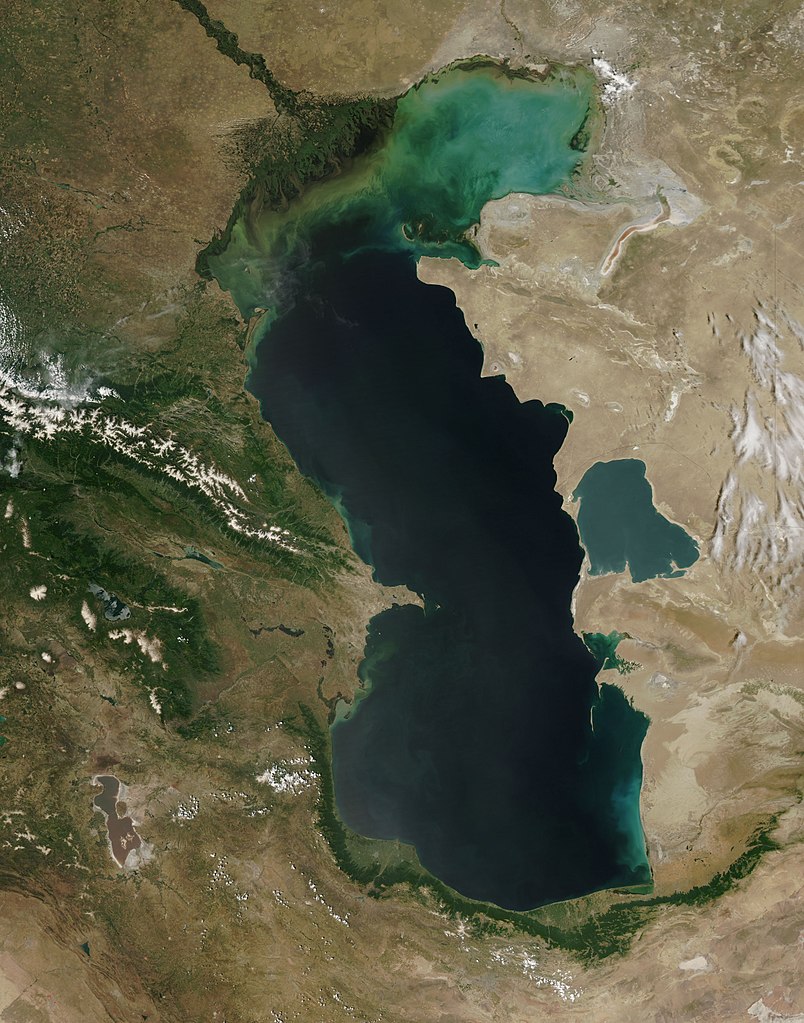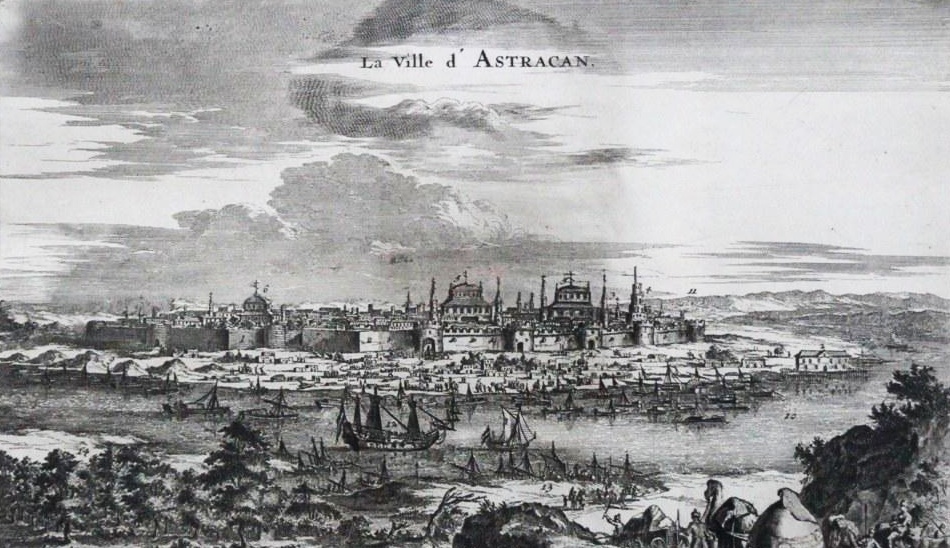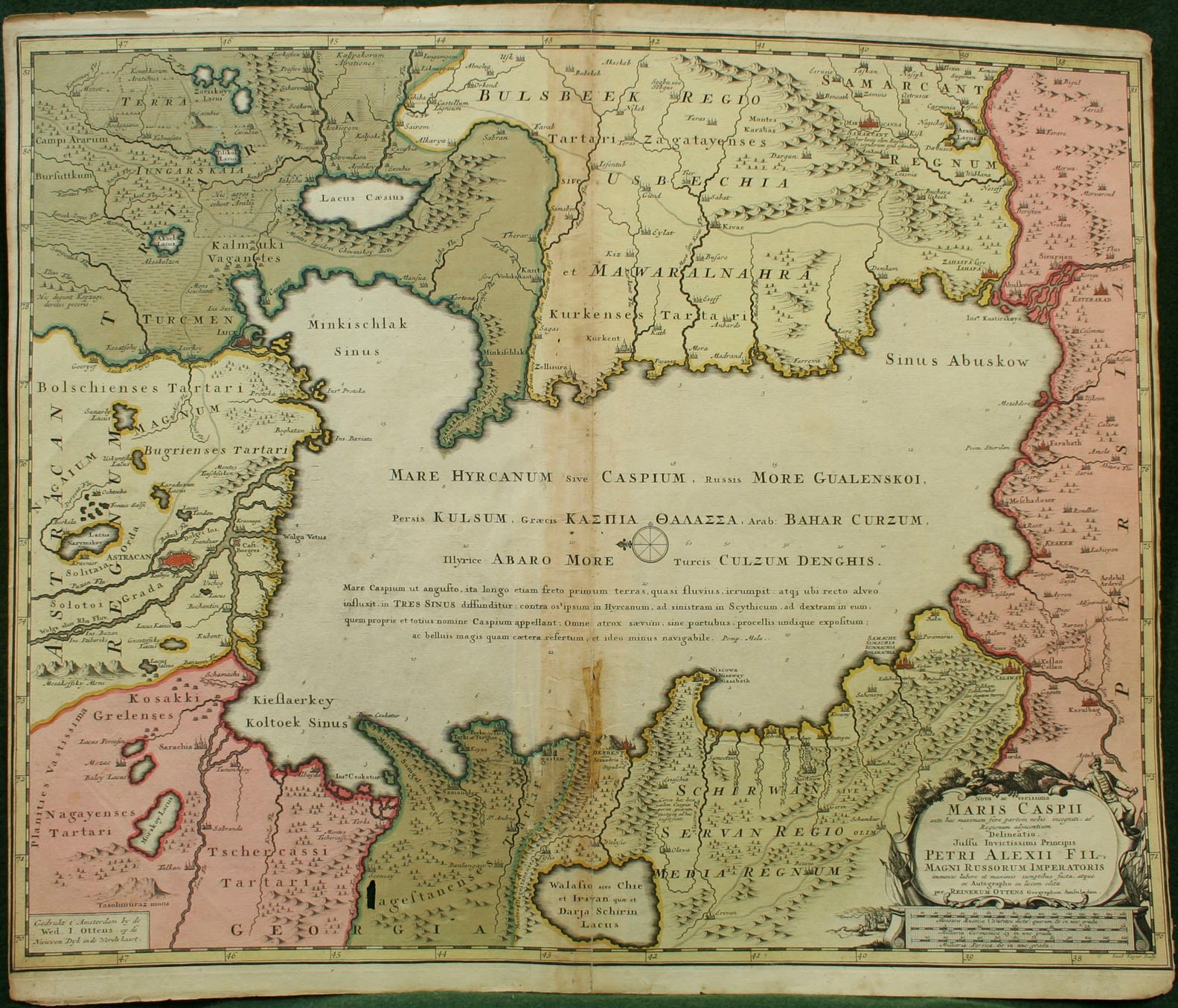| Golden Journal No. 30:
The Caspian Sea, Part One
by Mike Bennighof, Ph.D.
April 2020
 Earth’s largest inland sea, the Caspian Sea is larger than the Great Lakes, combined, and is counted as a “sea” thanks to its saline water. Geologically, it goes back about 30 million years; it became landlocked about 5.5 million years, and has been sustained by the powerful flow of the Volga River (and lesser flow of the Ural River). Earth’s largest inland sea, the Caspian Sea is larger than the Great Lakes, combined, and is counted as a “sea” thanks to its saline water. Geologically, it goes back about 30 million years; it became landlocked about 5.5 million years, and has been sustained by the powerful flow of the Volga River (and lesser flow of the Ural River).
The Caspian gets deeper from north to south; the very northern end is very shallow while the southern end (where it washes Iran’s north coast) can be quite deep. Because of the Volga’s input the northern end consists of almost fresh water, with the sea getting saltier the closer one comes to the south shore. The large bay on the sea’s east coast, known as the Kara Bogaz, isn’t navigable and at times has not been connected to the Caspian; for some decades in the last century it was cut off from the sea and dried out.
In the Middle Ages, the Amu Darya, Central Asia’s mighty river, flowed into the Caspian as well, but sometime during the 15th Century it changed its path to empty into what remains of the Aral Sea to the east of the Caspian. It apparently also flowed along a similar track between roughly the 6th Century B.C. and 4th Century A.D.
Both Pliny and Arrian write of how Chinese and Indian luxury goods flowed down the Amu Darya along the Silk Road, across the Caspian in ships to the opposite shore where they were taken by caravan into Roman territory, from whence they again were taken by river transport to Roman ports along the eastern coast of the Black Sea and on to the rest of the empire.
When the Amu Darya dried up, so did the trade. Russian Vikings known as the Rus sailed down the Volga in 943 to launch a series of brutal raids across the Caspian into Persian territory. Otherwise, the Caspian became a literal backwater for centuries, until the Russians reached its northern shore in 1558. Iva the Terrible ordered a fortress and city built at Astrakhan on the lower Volga, but Russian merchants had already crossed the sea in search of Persian goods.
Russian expansion halted for several decades following the death of Ivan the Terrible, a period known as the Time of Troubles. Finally in 1634, a delegation from the Duke of Holstein approached the first Romanov tsar, Michael I, with a trade proposition. They would short-circuit the maritime powers’ monopolies on trade with the east by opening a route down the Volga River and across the Caspian Sea to Persia. The tsar agreed, with the stipulation that the Holsteiners build ten large ships for the Russians using the latest Western methods, and employ and train Russian workers to do so.
Six shipwrights went to Nizhni Novgorod later that year and, with locally-recruited labor, built a a shipyard and began work on the promised ships. The first ship, named Friedrich in honor of the Duke of Holstein, launched later that year. She was built of pine planks and had three masts and 24 oars but flat-bottomed for river navigation. Recruiting and training the crew of 49, with German officers and sailors and Russian rowers, took some time and she wasn’t ready for her first voyage until the summer of 1636. Though sometimes called the first modern ship built in Russia, she flew the Holstein flag as she drifted downstream to the Caspian Sea.
Friedrich did not survive her maiden voyage on the Caspian Sea. She entered the sea in early November 1636 with 126 people aboard and ran into a storm six days later that drove her ashore near Derbent, in those days a Persian-ruled city on the south-western coast of the Caspian. The locals plundered the wreck, but most of her passengers and crew appear to have survived.

The frigate Orel and the city of Astrakhan.
The first modern warship built for the Caspian, Orel, was a Dutch-designed pinnace (in the parlance of the time, a small frigate) built at Dedinovo, on the Oka River east of Moscow. She carried 22 guns a crew of 23 sailors and 35 gunners. Launched in 1668 and commissioned in 1670, Orel was apparently the first warship to fly the Russian tricolor but it’s not clear whether she made any voyages before Cossack rebels led by Stepan Razin captured Astrakhan and the ship in 1670. The Cossacks made no effort to use the ship, nor did the Russians when they re-took the city a year later. Though she was said to have been burned by the Cossacks, it appears that she simply deteriorated thanks to the use of unseasoned wood in her construction.
When the Russians returned to Caspian waters, they did so in a big way. Tsar Peter the Great, flush with victories over the Swedes and Turks, looked to expand Russian power into the region. The Caspian had been a Persian lake for centuries, but the Safavid rulers apparently had no armed vessels on the sea and conducted little commerce there. With the Persian Empire crumbling under Afghan attack, Peter saw on opportunity to seize large stretches of formerly Persian territory and strategically outflank his Ottoman rivals. The campaign would “open the gates of Asia to us,” allowing Russia to dominate the rich trade between Europe and India.
Following his usual pattern, Peter prepared carefully for the coming campaign. In 1718 he established a shipyard at Kazan on the upper Volga, on the grounds of a confiscated monastery. Kazan lay in the midst of thick oak forests and already supplied timber to Peter’s new shipbuilding ventures on the Baltic coast. Four years later he ordered the Kazan yard to set up a subsidiary in Astrakhan.

A 1723 Russian map of the Caspian Sea; north lies to the left.
Russian expeditions scouted both coasts of the Caspian Sea, charting the coastline and probing the loyalties of the Persian subject peoples who lived there. The Khan of Khiva, correctly recognizing the harbingers of invasion, wiped out a Russian scouting party on his territory, but the others returned with enough useful information for the campaign to go forward.
Peter directed construction of a huge flotilla: 274 vessels, ranging from three-masted sailing vessels on down to oar-powered longboats, manned by 6,000 sailors. They would carry 22,000 soldiers from Astrakhan, while allied Cossack, Kalmyk and Caucasian tribes would march overland along the sea’s west coast.
The tsar himself commanded the 1722 campaign, the last time he would personally take the field. The Russians captured the key west coast cities of Baku and Derbent with the help of their local allies. Peter directed the 1723 campaign from Astrakhan, in which the Russians captured the Persian-held south coast. Before he could fulfill his goal of conquering the central Caucasus the Ottoman Turks invaded and took control. Peter concluded a peace with the Persians leaving him the all of his conquests and total domination of the Caspian Sea.
That would only last a decade or so; in 1732 and 1735 treaties Peter’s successors would return Persia’s north coast as the price of an alliance against the Ottoman Empire.
Click here to join the Gold Club.
See your Gold Club Insider newsletter for ordering information.
Sign up for our newsletter right here. Your info will never be sold or transferred; we'll just use it to update you on new games and new offers.
Mike Bennighof is president of Avalanche Press and holds a doctorate in history from Emory University. A Fulbright Scholar and NASA Journalist in Space finalist, he has published over 100 books, games and articles on historical subjects.
He lives in Birmingham, Alabama with his wife, three children and his dog, Leopold.
|
